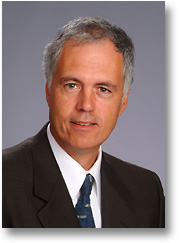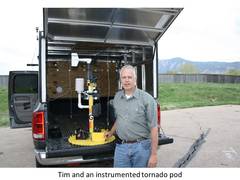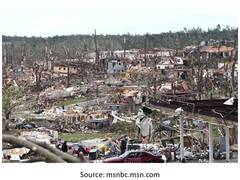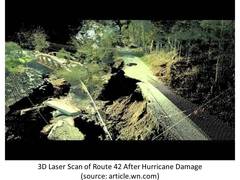
Name: Tim Marshall
- Education: M.S., Atmospheric Science, M.S., Civil Engineering and B.S., Meteorology
- Target Audience: Middle School
Tim Marshall's career ambitions came crashing in when a tornado struck his house as a child. Now, Tim spends his days assessing what he calls "Mother Nature's fingerprint" - the damage caused by weather. Read on to hear how an interest in destruction can lead to a career as a Failure and Damage Consulting Engineer!
What is your job?
I am a Failure and Damage Consulting Engineer and Meteorologist with Haag Engineering and my job is to look at the damage that comes from weather-related disasters. The mainstay of our business is mostly assessing hail damage to buildings but we are also involved when there is a major storm like a hurricane or tornado. The first question we answer when assessing damage is the yes/no question of "is it damaged or isn't it." Then, if it is damaged, we look at whether it can be repaired or replaced and calculate the costs involved.
Why did you choose this career?
Ever since I was a small child I have been interested in meteorology. When I was 10 years old a tornado came by my house in Illinois and seeing the damage it caused in my neighborhood hooked me. I really didn't know what this thing was that came out of the sky and did all of this damage, and I got very interested in the damage itself. I wanted to know how to assess and evaluate the damage, so I decided to make that my career. I looked around for places that specialized in disasters and I found a place called the Institute for Disaster Research at Texas Tech.
Explain what an average day at work is like for you.
 We never really know what we're going to be doing on any given day because we are essentially on-call 24/7. Someone may call us and report a roof that has collapsed from heavy rain, or there may be hail damage to assess. Hail damage is really the mainstay of our business, so we routinely schedule hail assessments. In the case of hail damage I try to do all of my fieldwork in the morning to avoid the heat. This leaves the afternoons open to file my reports.
We never really know what we're going to be doing on any given day because we are essentially on-call 24/7. Someone may call us and report a roof that has collapsed from heavy rain, or there may be hail damage to assess. Hail damage is really the mainstay of our business, so we routinely schedule hail assessments. In the case of hail damage I try to do all of my fieldwork in the morning to avoid the heat. This leaves the afternoons open to file my reports.
In the case of a major disaster, like Hurricane Katrina, we have to work a lot harder and a lot longer. We usually rent a series of apartments or hotel rooms, set up an office, and stay there for weeks or months. We conduct fieldwork 7 days a week from sun up to sun down after these disasters, and we continue to do this until the entire area has been assessed. When I personally worked on Hurricane Katrina I stayed in a rental house in Mobile, Alabama for 9 straight weeks, then I rotated in and out every other week. Since the disasters don't come to us, we go to the disasters. I travel all over the country to conduct these assessments, and that is one thing about this job that you either like or don't like.
What do you like best about your job?
I am always awed and amazed by the power of Mother Nature. The damage caused by weather is really Mother Nature's fingerprint, and we can learn a lot by looking at this damage. I get to see firsthand where the fatal flaws are in building construction by seeing how they fall apart. I give lectures based upon my surveys and hope to spread the word about the problems in building construction and what can be done to try to fix these problems.
When you were a kid, did you like science and engineering?
 Ever since I was young I was into science. When I was 7 years old my parents asked me what I wanted for Christmas, and I didn't hesitate to tell them that I wanted a barometer. With this barometer I would take weather records at the same time every day and give the daily weather forecast to the kids in my neighborhood. It's no surprise that my neighborhood came to know me as the weather man on the block. I even still have the journal that I recorded all of my readings in!
Ever since I was young I was into science. When I was 7 years old my parents asked me what I wanted for Christmas, and I didn't hesitate to tell them that I wanted a barometer. With this barometer I would take weather records at the same time every day and give the daily weather forecast to the kids in my neighborhood. It's no surprise that my neighborhood came to know me as the weather man on the block. I even still have the journal that I recorded all of my readings in!
Meteorology was my first love, and engineering is my second love. I like to build things, but as a child I also liked to destroy things. I always had an interest in how things fail, and that's where the engineering part came in.
Was there a moment when you knew that you wanted to become a meteorologist and engineer? Tell us about it.
There are things along the way that are totally unexpected. When I was in high school, they announced over the intercom one day that there was going to be a weather club that was going to form at the high school if there were enough people interested. I went to the first meeting and found out that there were a lot of kids that were interested in weather. We went on field trips and we encouraged the school so much that my senior year of high school they offered a weather course, which of course we all took.
When I went to college and majored in meteorology at Northern Illinois University, I realized that the best place to see severe weather up close is Texas. Texas has both tornados and hurricanes, so I applied to different schools in the state. Texas Tech actually paid me money to go there as a graduate student to teach meteorology and do research on tornados and hurricanes, and of course the damage that they cause.
What was the biggest challenge you faced in your journey to becoming an engineer?
First of all, there were always financial challenges. I was not a wealthy child by any means; I got through college, in part, by teaching guitar. Being motivated was never a problem for me, but the uncertainty of the available opportunities was something that I had no control over. I had no control over the weather club being formed, or the fact that Texas Tech would accept me and pay me to study there. The fact that I had no control over these opportunities was a bit unnerving at times.
Was there a person who inspired or convinced you to get involved in your field? Who was he/she and how did he/she do it?
There are a number of people who have inspired me along the way. One of my earliest mentors and inspirations was Jack Villmow, a professor in the geography department at Northern Illinois University. Dr. Ted Fujita at the University of Chicago also inspired me. When I came to Texas Tech, I met Dr. Minor, Dr. McDonald and Dr. Mehte who headed the Institute for Disaster Research. I thought it was quaint that my last name was Marshall and started with an M just like these professors! They treated me like a colleague as soon as I arrived at the institute and encouraged me even afterward I left.
They always had a lot of fieldwork for me to do. When Hurricane Allen hit south Texas in 1980, we went down by the Gulf, rode the hurricane out in Corpus Christi and then immediately conducted a survey afterwards. That was the first hurricane that I ever rode out and I liked it. A lot of people flee during hurricanes, but I really liked being there for it. That same year a series of tornados hit Grand Island, Nebraska and caused substantial damage. We assessed this damage not only from the ground, but also from the air in Huey Helicopters. I got to ride on the edge of the seat with an open door while flying at 250 feet above the ground and I took my notes and pictures from there. They really encouraged this interest in me and I knew this was what I wanted to do.
Do you have any suggestions for how students in middle school can get practical experience in your field?
If you have an interest in weather, the internet is a wonderful resource to search for whatever interests you. Check to see if the National Weather Service offers free spotter training sessions in your area. These training sessions are free and open to the public, and participating in them makes you a certified storm spotter.
Also, take a lot of science and math courses in school. If you like damage and destruction like I like damage and destruction, learn about tornados and hurricanes and the damage they cause.
Which high school courses would you recommend to incoming high school students?
The obvious courses of science, math, physics and chemistry are all important to take. Computer science is also becoming more important to this field. If your high schools offers specialty courses such as meteorology or engineering, those would definitely be a good idea as well.
Are there exciting things happening in your field that could involve students who will enter the field in 10-15 years?
 Our company is growing very rapidly, and we are getting involved with technology that we never even thought of 10 years ago. One example of technology is called 3-D scanning. 3-D scanning provides devices that can be placed on a tripod, and will scan the scene in 3-D. This allows us to be able to scan the scene then view it in its entirety virtually on a computer. It is amazing what technology has done to this field. We used to spend days taking measurements in the field, but we don't have to do this anymore thanks to 3-D scanning.
Our company is growing very rapidly, and we are getting involved with technology that we never even thought of 10 years ago. One example of technology is called 3-D scanning. 3-D scanning provides devices that can be placed on a tripod, and will scan the scene in 3-D. This allows us to be able to scan the scene then view it in its entirety virtually on a computer. It is amazing what technology has done to this field. We used to spend days taking measurements in the field, but we don't have to do this anymore thanks to 3-D scanning.
It's hard to predict what type of technology will be out 5-10 years from now, but the field of failure analysis will still be around and in much more demand. There will be more people in the future, and the presence of more people means more accidents and more failures. More people are moving into the floodplains and will eventually experience floods. More people are moving to the coastlines, and will be threatened by hurricanes and heavy storms. When these things occur, the damages will need to be assessed.
Crash Course on Disasters:
- Hurricane Katrina was one of the worst disasters in U.S. history, and the total cost of the damage is estimated at $81 billion (with a b!).
- The largest hailstone in U.S. history occurred in 2003 and was 7 inches wide. That is almost as large as a soccer ball! (http://news.nationalgeographic.com/news/2003/08/0804_030804_largesthailstone.html)
- Proper building construction is very important when trying to prevent damage during natural disasters. During the major earthquake that hit Japan in 2011, earthquake-resistant building construction is suspected to have saved thousands of lives. "Such features as extra steel bracing, giant rubber pads and embedded hydraulic shock absorbers in high buildings make modern Japanese buildings among the sturdiest in the world during a major earthquake." (http://constructionlawnc.com/2011/03/18/japan-earthquake/)
Key Terms:
Barometer: Any instrument that measures atmospheric pressure.
Floodplain: A nearly flat plain along the course of a stream or a river that is naturally subject to flooding.
Hurricane Katrina (2005): the costliest natural disaster, and one the deadliest hurricanes in the history of the US. Katrina reached category 5 status over open water, and made landfall on the Gulf Coast as a category 3 storm.
(As adapted from dictionary.com)


















